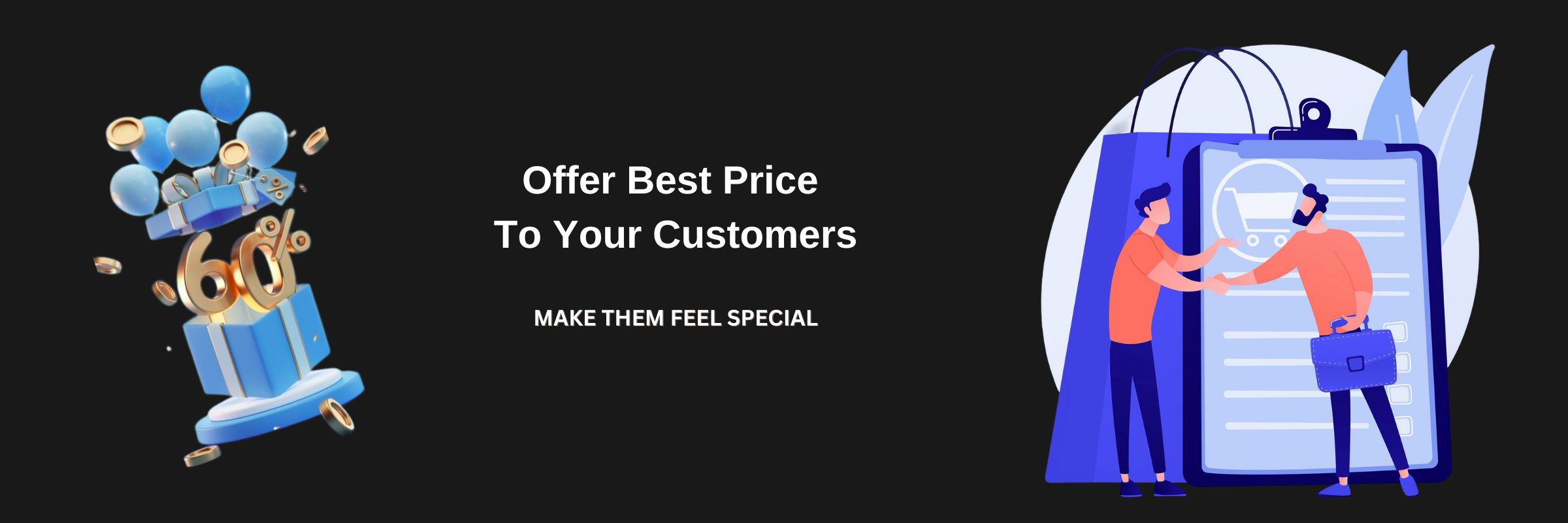
Unlocking Business Growth: The Strategic Advantage of Custom Pricing and Discount Features in B2B eCommerce
Explore how custom pricing and discount features in B2B eCommerce apps empower businesses to drive sales and customer satisfaction.
- .

In the competitive arena of B2B eCommerce, where bulk deals and repeat business define profitability, pricing flexibility is no longer optional—it’s a strategic imperative. According to Forrester, B2B eCommerce will reach over $3 trillion in sales by 2027, and a key driver of this growth is the ability to tailor experiences, especially pricing. Today’s digital-first buyers demand more than just access to products; they expect pricing that reflects their history, volume, contracts, and loyalty.
Unlike B2C platforms, where pricing is mostly static and promotional, B2B buyers expect negotiations, bulk discounts, long-term agreements, and tailored offers. A Deloitte study found that 73% of B2B buyers prefer to purchase from digitally enabled suppliers that personalize offers and pricing. Without intelligent pricing features, businesses risk losing deals to more agile competitors who can accommodate buyer expectations instantly and transparently.
Advanced B2B eCommerce apps can turn static pricing into intelligent, personalized engines that maximize margins, drive conversions, and simplify sales operations. Let’s explore in-depth how these custom pricing and discount features deliver business-critical benefits.
1. Flexible Pricing Models that Scale with Business
- Volume-Based Pricing:
Offer progressive discounts as purchase quantities rise. This incentivizes bulk buying, reduces cost per unit, and improves cash flow. According to a McKinsey study, businesses that tailor pricing by volume can see up to 8% increase in profits.
Example: An industrial supplier offering bearings or fasteners may offer 5% off orders above ₹1,00,000, scaling up to 12% above ₹3,00,000, pushing clients to consolidate orders.
- Tiered Pricing:
With tiered pricing, buyers are motivated to spend more to access the next discount level. It’s an effective psychological driver for increasing average order value (AOV).
Example: A client buying SaaS tools may get 10 users for ₹9,999 but gets 20 users for ₹14,999—a compelling upsell opportunity.
- Contract Pricing:
Custom-negotiated pricing based on long-term agreements builds trust, stabilizes costs for buyers, and ensures recurring revenue for sellers. Such pricing also streamlines approval cycles for procurement departments.
Example: An FMCG distributor might sign a yearly deal with a retail chain at fixed rates regardless of seasonal fluctuations.
2. Discount Rules Engine for Smarter Promotions
- Time-Based Promotions:
Create urgency and drive purchases during specific windows—end of quarter, festive seasons, or product launches. Businesses can align discounts with marketing campaigns for higher ROI.
Example: A B2B apparel wholesaler offering a 15% discount during pre-Diwali weeks to clear out last season’s stock.
- Customer Segmentation Discounts:
By analyzing customer behavior, industries, or geographies, discounts can be precisely targeted. Loyalty-based segmentation can reward repeat clients with exclusive incentives.
Example: Hospitals ordering medical supplies monthly receive a loyalty discount, while new buyers get a first-purchase offer.
- Product-Specific Discounts:
Boost sales of slow-moving or high-margin products with targeted discounts. Helps in inventory turnover and revenue maximization.
Example: A tool supplier may offer a 20% discount on drills nearing end-of-life in the product line.
3. Automated and Error-Free Discount Application
- Rules Engine Integration:
Predefined rules automate discount calculations, eliminate manual errors, and ensure consistent user experience. This improves trust and speeds up transactions.
Example: Discounts automatically apply at checkout once volume thresholds or coupon codes are met.
- Coupon Code Support:
Coupons enable marketers to track campaign ROI while giving customers a sense of exclusivity. Can be tied to email campaigns, partner promotions, or event offers.
Example: A webinar attendee receives a unique 10% discount code valid for 7 days.
4. Quotation & Approval Workflows for Custom Deals
- On-Demand Quote Generation:
Let buyers request personalized pricing within the app. This is essential in high-value or configurable products where standard pricing doesn’t suffice.
Example: A construction firm ordering bulk cement can request a custom quote considering logistics and project duration.
- Approval Chains:
Ensure every custom quote or override goes through a structured, multi-level approval—reducing revenue leakage and protecting margins.
Example: Any discount beyond 15% triggers approvals from regional managers in the workflow.
5. Harnessing Dynamic, Market-Responsive Pricing
- Real-Time Adjustments:
Respond to inventory levels, demand, or supply chain disruptions by adjusting prices instantly. Businesses using real-time pricing gain agility in volatile markets.
Example: Lower prices on surplus inventory or raise prices during demand spikes like COVID-era essentials.
- Competitive Price Matching:
Stay aligned with market rates by tracking competitor pricing and adjusting your offers accordingly—without compromising profitability.
Example: Auto-parts resellers dynamically adjust SKUs when top competitor prices drop within a defined range.
6. Transparent and Trustworthy Discount Communication
- In-App Clarity:
Clearly show applied discounts, original price, and net payable—removing ambiguity and boosting buyer confidence.
Example: During checkout, a summary shows, “You saved ₹3,500 with your tiered discount.”
- Audit Trails:
Every pricing change or discount application is logged, enabling traceability for compliance and dispute resolution.
Example: When a client questions pricing, customer support can access historical records instantly.
7. CRM & ERP Integration for Seamless Workflows
- CRM Sync:
Leverage buyer data—purchase history, preferences, and engagement—to offer personalized pricing that improves close rates.
Example: A returning customer gets pricing based on past bulk orders, automatically applied.
- ERP Integration:
Sync pricing rules with your ERP for consistent invoicing, tax calculation, and stock reconciliation.
Example: Discounts applied in the app reflect in SAP or Odoo instantly for finance teams.
8. User-Friendly Admin Interface for Easy Control
- No-Code Dashboard:
Empower non-tech teams to manage complex pricing rules without developer support. Reduces time-to-market for new offers.
Example: Sales ops can launch a flash discount in minutes via an admin portal.
- Custom Analytics Dashboards:
Track campaign performance, client-wise pricing, and order trends in real-time—backed by visual dashboards.
Example: Identify top 5 clients availing highest discounts and their impact on revenue.
9. Security & Compliance at Every Step
- Role-Based Access Control:
Limit pricing controls to authorized roles. Prevents accidental or malicious changes that could damage margins.
Example: Only finance and sales directors have permission to alter contract pricing tiers.
- Data Protection Compliance:
Ensure encryption and DPDP/GDPR compliance to protect sensitive pricing data and client contracts.
Example: All pricing APIs are secured and logged with access time, user ID, and purpose.
10. Analytics & Reporting for Smarter Pricing Decisions
- Performance Reports:
Track which discounts drive conversions, repeat orders, or client churn. These insights guide future pricing strategies.
Example: Discover that first-order discounts outperform loyalty offers for new customer acquisition.
- Behavioral Insights:
Analyze customer responsiveness to pricing tactics across segments—refine offers accordingly.
Example: Manufacturing clients respond more to bulk-based pricing; service-based clients prefer subscription discounts.
Final Thoughts: Pricing as a Competitive Weapon
Custom pricing and discount features are not just operational tools—they’re strategic levers. With the right implementation, B2B platforms can deliver value-driven pricing experiences that turn transactions into relationships.
Businesses that embrace dynamic, tailored pricing strategies gain the agility to adapt to customer demands, market changes, and growth targets with confidence.
Ready to build or optimize your B2B eCommerce app with intelligent pricing features? Partner with a tech team that understands your domain, industry challenges, and strategic goals—and delivers solutions that scale.








 05 Apr 2025
05 Apr 2025 8 mins to read
8 mins to read


